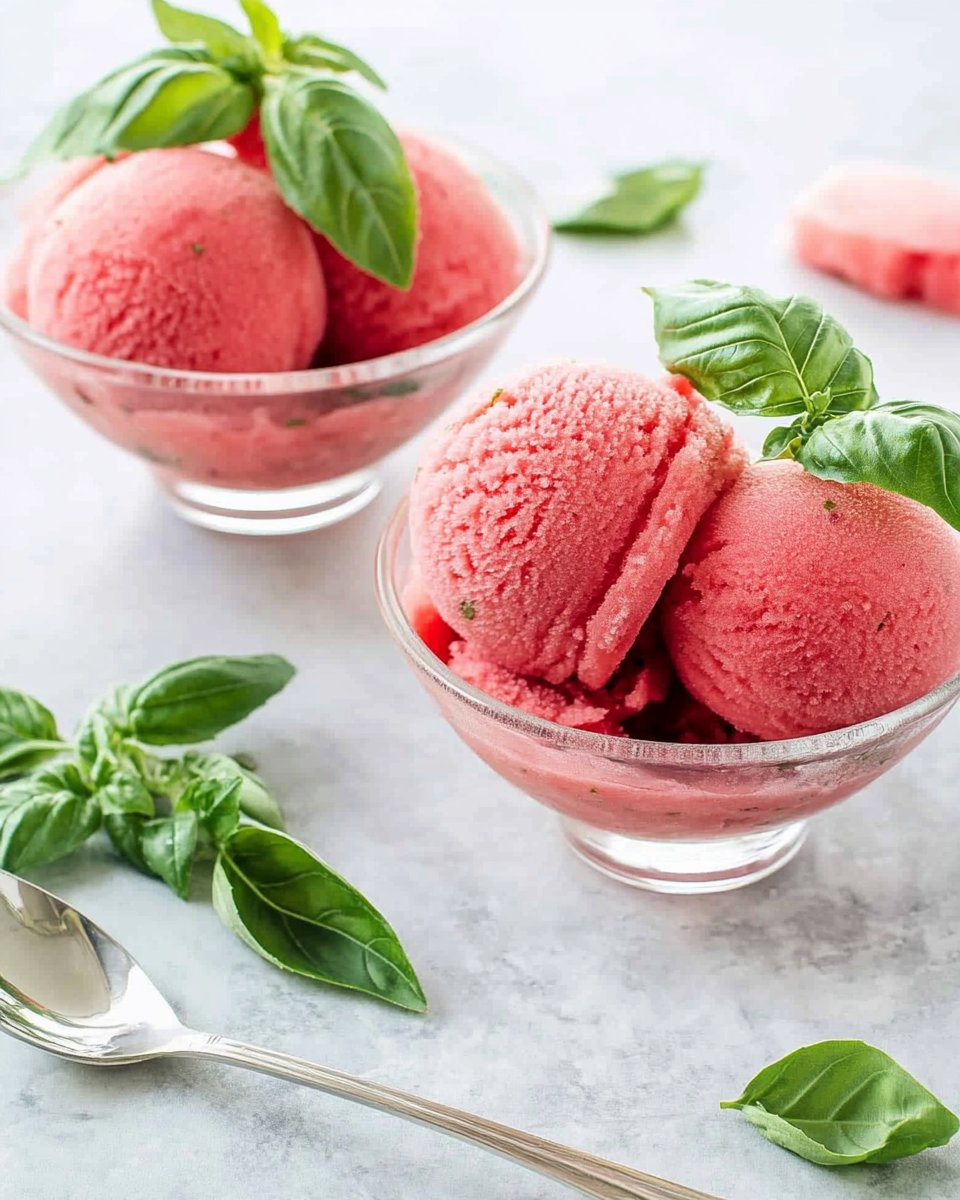This refreshing Watermelon Basil Sorbet is the perfect summer treat—light, fruity, and bursting with flavor. The sweetness of ripe watermelon pairs beautifully with the herbal notes of fresh basil, making it a unique and delightful frozen dessert. Plus, it’s dairy-free and low in calories!
FULL RECIPE
Ingredients
- 4 cups watermelon (seedless, cubed)
- ½ cup water
- ½ cup granulated sugar (or honey for a natural sweetener)
- 2 tablespoons fresh basil leaves, chopped
- 1 tablespoon lime juice
- Pinch of salt
Directions
- In a small saucepan over medium heat, combine the water and sugar. Stir until sugar is completely dissolved to make a simple syrup. Remove from heat, add chopped basil, and let steep for 15 minutes. Strain and discard basil leaves.
- In a blender, add watermelon cubes, lime juice, and the basil-infused syrup. Blend until smooth.
- Strain the mixture through a fine mesh sieve for a smoother texture (optional).
- Pour the mixture into a shallow dish or loaf pan. Freeze for 3–4 hours, stirring every 30 minutes with a fork to break up ice crystals, until it reaches a sorbet-like consistency.
- Serve immediately for a soft texture, or freeze overnight and let sit at room temperature for 10 minutes before scooping.
Nutrition Facts
- Calories: 88
- Total Fat: 0.2g
- Saturated Fat: 0g
- Trans Fat: 0g
- Cholesterol: 0mg
- Sodium: 3mg
- Total Carbohydrates: 23g
- Dietary Fiber: 1g
- Total Sugars: 20g
- Added Sugars: 12g
- Protein: 0.7g
- Vitamin A: 870 IU (17% DV)
- Vitamin C: 12mg (20% DV)
- Calcium: 10mg (1% DV)
- Iron: 0.4mg (2% DV)
- Potassium: 170mg (5% DV)
History and Origin of Sorbet
Sorbet is a frozen dessert that dates back to ancient times, with origins traced to the Middle East and Mediterranean regions. Traditionally, sorbets were made from naturally available fruits, herbs, and ice or snow, which was used as a cooling agent. Over time, sorbet recipes evolved, spreading through Europe, where they became popular among nobility during the Renaissance. Sorbet differs from ice cream primarily because it contains no dairy, making it a lighter, refreshing alternative.
The Role of Watermelon in Sorbet
Watermelon is the star ingredient of this sorbet, known for its high water content (about 92%), natural sweetness, and vibrant pink color. Its juicy flesh provides an ideal base for frozen desserts because it freezes well while maintaining flavor and texture. Watermelon also contributes hydration and essential vitamins, making the sorbet both delicious and nutritious.
Why Basil Complements Watermelon
Basil adds an aromatic herbal note that elevates the flavor profile of the sorbet. The slightly sweet, peppery taste of fresh basil balances the natural sweetness of watermelon, adding complexity and freshness. Using herbs like basil in fruit sorbets is a classic culinary technique to enhance and contrast flavors, making the dessert more interesting and unique.
Health Benefits of Watermelon Basil Sorbet
This sorbet is not only refreshing but also offers health benefits. Watermelon is rich in antioxidants such as lycopene, which supports heart health and may reduce inflammation. Basil contains essential oils that have anti-inflammatory and antibacterial properties. The sorbet is low in fat and calories, making it a guilt-free dessert option that can fit into various healthy eating plans.
The Science of Freezing Sorbet
Sorbet’s texture is a result of carefully controlled freezing. Unlike ice cream, sorbet lacks fat and milk solids, so its smoothness depends on the sugar content and how often it is stirred during freezing to prevent large ice crystals. This recipe uses a simple syrup infused with basil to control sweetness and texture while enhancing flavor. Regular stirring breaks up ice crystals, resulting in a creamy consistency without any dairy.
Sugar and Sweeteners in Sorbet
The sugar or sweetener in sorbet isn’t just for taste; it plays a crucial role in texture and freezing point depression. Too little sugar and the sorbet becomes hard and icy, while too much can prevent it from freezing properly. This recipe uses granulated sugar or honey, allowing flexibility for different dietary preferences. The balance of sweetness ensures the sorbet remains soft and scoopable straight from the freezer.
Lime Juice’s Function in Sorbet
Lime juice adds a burst of acidity that brightens the flavor and balances the sweetness of the watermelon and sugar. The acidity also helps to preserve the vibrant color of the watermelon and acts as a natural preservative, slowing down oxidation and maintaining freshness. The citrus element creates a more complex and refreshing taste experience.
Dairy-Free and Vegan Appeal
Sorbet is naturally dairy-free, making it suitable for vegans and those with lactose intolerance or dairy allergies. This Watermelon Basil Sorbet is an excellent dessert choice for people following plant-based diets. Its simple ingredients and fresh flavors cater to modern dietary trends emphasizing whole, natural foods without animal products.
Seasonal and Sustainable Eating
Using watermelon and basil, which are both abundant in summer, aligns with the concept of seasonal eating. Eating seasonally supports local agriculture and reduces environmental impact related to food transportation and storage. This recipe encourages consumers to enjoy fresh, local produce at its peak, enhancing both flavor and nutritional value.
Creative Variations and Serving Ideas
This sorbet is versatile and can be customized with different herbs like mint or thyme, or by adding complementary fruits such as strawberries or lime zest for extra zing. Serving suggestions include pairing with fresh berries, mint leaves, or a drizzle of balsamic reduction for an elegant presentation. It can also be served as a palate cleanser between courses or as a light dessert after meals.
Storage and Shelf Life
Proper storage is essential to maintain the quality of sorbet. Store it in an airtight container to prevent freezer burn and absorption of odors from other foods. Sorbet is best consumed within one to two weeks for optimal texture and flavor. Allowing it to sit at room temperature for a few minutes before serving helps soften it for easier scooping.
Sorbet in Modern Cuisine
Sorbet has become popular in contemporary cuisine, appreciated for its clean flavors and refreshing qualities. Chefs often use sorbet as a palate cleanser during multi-course meals or as a sophisticated dessert option. Its dairy-free nature makes it an important inclusion in menus catering to diverse dietary needs without sacrificing taste.
Environmental Impact and Homemade Benefits
Making sorbet at home reduces packaging waste compared to store-bought frozen desserts, contributing to lower environmental impact. Homemade sorbet also allows control over ingredients, avoiding artificial additives and excessive sugars. This Watermelon Basil Sorbet offers a fresh, wholesome alternative that supports sustainability and healthier eating habits.
Conclusion
Watermelon Basil Sorbet is more than just a sweet treat; it embodies a blend of history, nutrition, culinary artistry, and sustainable living. Its simple, natural ingredients deliver complex flavors and health benefits, while the method of preparation ensures a delightful texture and refreshing experience. Perfect for warm days or as a light dessert, this sorbet showcases how traditional techniques and fresh produce can create modern, wholesome delights that suit a wide range of dietary preferences and lifestyles. Incorporating this sorbet into your recipe collection or menu can provide a healthy, flavorful option that guests and family will appreciate time and again.






